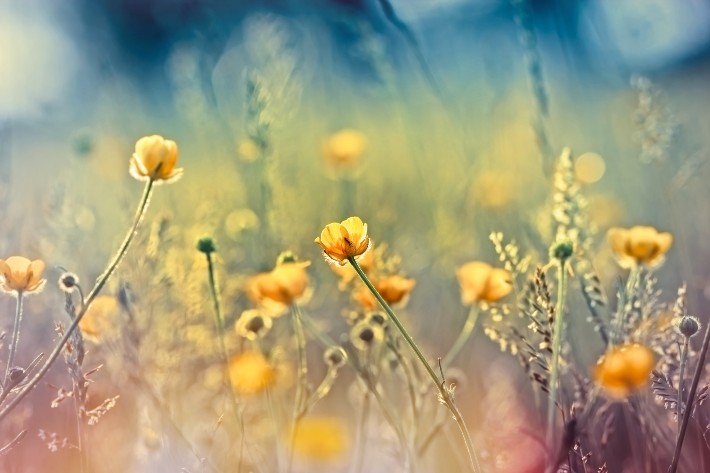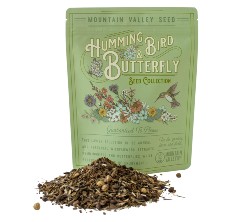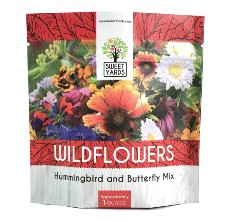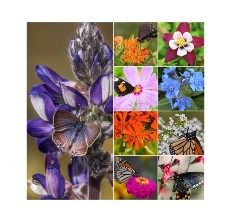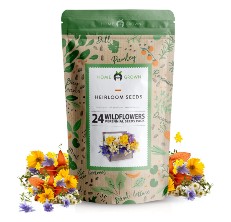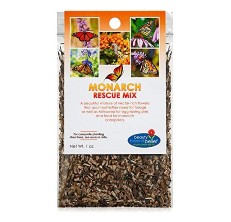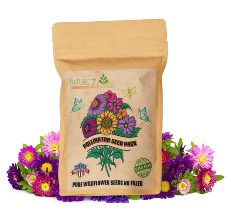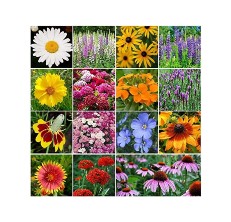- Flowers & PlantsVegetablesOur content is meticulously curated through independent research, testing, reviews, and AI-driven recommendations, all designed to present you with the finest product choices. When you make a purchase through our links, it could result in us earning a commission.
The Best Wildflower Seed Mix of 2024
Last updated: Apr 23, 2024
If you have your own outdoor space, why not make the most of it? Wildflower gardens will attract critters while adding colorful hues and an aromatic appeal to your outdoor space. For instance, some perennial wildflowers attract insects like lacewings, ladybugs, hoverflies, and parasitic wasps, all of which protect against harmful pests, like mites. But how do you know which wildflowers are worth growing in your garden? We suggest giving the Mountain Valley Seed Company Wildflower Seed Mix a try, and don’t forget to read our buying guide!
Our Top Picks For Wildflower Seed Mix
- Best Overall: Mountain Valley Seed Company Wildflower Seed Mix Shop Now ➔
- Runner Up: Sweet Yards Wildflower Seed Mix Shop Now ➔
- Honorable Mention: Seed Needs Bird and Butterfly Wildflower Seed Mix Shop Now ➔
- Contender: HOME GROWN Wildflower Seed Mix Shop Now ➔
- Also Consider: Beauty Beyond Belief Monarch Butterfly Wildflower Seed Mix Shop Now ➔
- Also Consider: NatureZ Edge Wildflower Seed Mix Shop Now ➔
- Also Consider: Eden Brothers All Perennial Wildflower Seed Mix Shop Now ➔
The Best Wildflower Seed Mix
Best Overall
The Mountain Valley Seed Company Wildflower Seed Mix contains around 80,000 seeds. That is a lot of seeds, so it’s the perfect mix for large gardens. However, if you have a small garden, this wildflower seed mix is still suitable because planting more seeds than you think you need is always a good idea. That way, you’ll increase your chances of growing plenty of flowers, making this wildflower seed mix our top pick.
Pros
- Massive amount of seeds
- Produces a variety of flowers
- Attracts bees, hummingbirds, and butterflies
Cons
- Might be smaller than expected
Runner Up
The Sweet Yards Wildflower Seed Mix contains over 7,500 seeds. That’s more than enough to cover about 100 square feet, which is the size of a medium yard. The seeds include Asclepias Tuberosa, Cosmos Bipinnatus, and 21 other flower species. When you plant these seeds in your garden, you’ll attract several types of critters, including hummingbirds and butterflies. Packaged with a resealable zipper, you can save seeds for the following year as needed. Plus, this wildflower seed mix comes with clear instructions on how to sow your flowers successfully.
Pros
- Yields 23 varieties of flowers
- Money-back guarantee if no growth
- Comes in resealable packaging
Cons
- Some seeds might not grow into flowers
Honorable Mention
The Seed Needs Bird and Butterfly Wildflower Seed Mix contains a massive quantity of 30,000 seeds. The pack has 23 species of flowers, with the majority of them being annual, meaning you can redesign your garden easily every year. Some of the seeds include Butterfly Milkweed, Toadflax, Chinese Forget-Me-Not, and Scarlet Sage. These non-GMO flowers will attract various forms of butterflies, bees, and hummingbirds.
Pros
- Comes with many seeds
- Includes annuals, perennials, and biennials
- Packed with non-GMO seeds
Cons
- Can only be used for one season
Contender
One pack of the HOME GROWN Wildflower Seed Mix provides enough seeds to cover 400 square feet. It contains 24 varieties of different flower seeds, including White Yarrow, Cornflower, Columbine, Shasta Daisy, Clarkia, Farewell to Spring, Lance Leaf Coreopsis, Plains Coreopsis, Chinese Forget-Me-Not, Cosmos, Sweet William, Larkspur, African Daisy, California Poppy, Purple Coneflower, Annual Baby’s Breath, Indian Blanket, Blue Flax, and Tree Mallow. All of the seeds are naturally sourced without any fillers, so you can buy in confidence knowing that your flowers will bloom.
Pros
- No fillers in the packs
- 24 flower varieties
- Up to 400 square feet of coverage
Cons
- Does not contain instructions
Also Consider
A pack of the Beauty Beyond Belief Monarch Butterfly Wildflower Seed Mix contains non-GMO flower seeds without any fillers. This pack includes a variety of perennial and annual flower seeds that were explicitly chosen to attract beautiful Monarch butterflies. Adhere to the easy-to-follow instructions that come with the mix and you’ll be sure to grow a beautiful flower garden in the spring. As an added bonus, this product supports the BBB gardening education program
Pros
- Supports a gardening education initiative
- Attracts Monarch butterflies to your garden
- Clear instructions provided
Cons
- Seeds require different environmental conditions
Also Consider
With the NatureZ Edge Wildflower Seed Mix, you’ll gain access to 35 varieties of flower seeds. This pack of seeds covers up to 500 square feet on its own. It includes both perennial and annual flowers, so you can change things up next year while keeping a few of the flowers for even longer. Additionally, the flowers produced with this pack will attract various pollinators to your garden, including butterflies, bees, and hummingbirds. Plus, the seeds are hand-picked by a veteran-run small family business.
Pros
- Support a veteran-run family business
- Attract various wildlife to your garden
- 35 varieties of flower seeds
Cons
- Seeds have differing needs
Also Consider
The Eden Brothers All Perennial Wildflower Seed Mix provides one pound of seed mix. It includes 15 varieties of flowers, including Blanket Flower, Black-Eyed Susan, Blue Flax, Candytuft, Foxglove, Gloriosa Daisy, Lance-Leaf Coreopsis, Liatris/Gayfeather, Maltese Cross, Mexican Hat, Purple Coneflower, Shasta Daisy, Siberian Wallflower, Sweet William, and Wild Perennial Lupine.
Pros
- Includes perennial flower seeds
- Seeds cover up to 1,000 square feet
- High germination rate
Cons
- Need to wait one year after planting
Key Features
This assortment of flowers will create a rainbow of colors in your garden from spring to summer. This seed mix was created to give you flowers that bloom at slightly different times, creating a wide range of colors for a long season.
The Best Wildflower Seed Mix: A Buyer's Guide
What Are Wildflower Seeds?
Wildflower seeds are packs of seeds that can be planted in your garden to produce a vibrant collection of flowers. If you want to make your entire meadow burst into life with little rhyme or reason, wildflower seeds may be the way forward.
While wildflower seeds are perfect for your garden during the summer season, they can be saved once temperatures starts to fall low enough to kill wildflowers. Collecting seeds from the wildflower garden to plant the next season is one of the most rewarding, and economical gardening practices.
Check the video below for tips on saving wildflower seeds for use next season.
Things To Consider When Choosing Wildflower Seeds
Wildflower gardening is fairly straightforward. When choosing the best flower seed, there are few things you may wish to consider. For your flowers to bloom, you must make sure, amongst other things, that the wildflower seeds are compatible with your garden. Continue reading to see the factors you should consider when buying wildflower seeds.
Soil compatibility
When searching for your perfect seeds, you need to ensure that the type of soil in your garden matches the soil required by the seeds to grow. Alternatively, you can add things to your soil to make it more suited to the flowers you choose, such as sand or fertilizer. However, it is important to note that most wildflowers thrive without the need for fertilizer. Therefore, if you use it without being instructed to do so, you may inadvertently create a hostile environment for your flowers.
Light
When choosing wildflower seeds, consider how much light the flowers require for growth. Many seeds require a lot of sunshine, and some prefer shade. There will be a compatible seed for whatever amount of light your wildflower garden receives.
Pets
If you have pets, it is important to check the flowers you are planting are not toxic to them. Foxgloves, for instance, are poisonous to horses. So take some time and research online every type of flower in the wildflower seed mix. The safety of your fur baby is worth a little extra effort.
Color scheme
If you have specific colors in mind, you might wish to buy your wildflower seed based on the flowers’ colors. Purples, blues, and pinks will create a mild effect in your wildflower meadow, and reds, yellows, and oranges will add a little energy to it. Alternatively, you can plant perennial wildflowers of every color.
Height
You may wish to plant flowers that grow to a certain height. If you want your garden to look uniform, this might be an important factor for you. Some manufacturers will state the average size of the flowers; others may not, so it will take a little online research to find out.
Different seed requirements
When buying a wildflower seed packet, you can opt for seeds with the same or different environmental requirements. For example, if you are planting the seeds in one particular spot, it is worth buying seeds with the same growth requirements. This includes soil type, nutrition, light, and moisture. However, if you are scattering the seeds around different parts of your garden, using seeds that flourish in various environments will increase your chances of flowers growing in multiple locations. Also, check the complete planting instructions on the back of the packet to learn more about the growing season and soil conditions.
Non-GMO
While looking for wildflower seeds, you may notice a lot of manufacturers advertise that they are non-GMO. A GMO is a genetically modified organism. Companies will often genetically modify crops to give them specific properties, such as corn with larger kernels. With that said, it is possible to genetically modify flowers to have brighter shades of color or any number of different features.
Many people believe that plants should be left as God intended them to be. In addition, some people believe that GMOs might negatively affect pollinators. However, there has been no evidence or indication that this is the case. Therefore, if you would rather have completely natural flowers, opt for non-GMO wildflower seeds.
Support good causes
When buying any product, you should check to see if purchasing the product supports any good causes. For example, you may notice that many wildflower seed companies give a portion of their money to wildlife charities or use some of the money to fund their charitable initiatives. These are often to do with helping the environment or educating people about gardening and wildlife.
Filler
Many people are put off by the “filler” in a pack of wildflower seeds; however, this filler will often have essential nutrients to help the seeds grow. To ensure the filler is helpful to your seeds, contact the manufacturer and find out what is in it. Alternatively, choose a pack with no filler and provide any nutrients that the flowers need separately.
Resealable packaging
If you buy a large number of seeds, you should buy a resealable pack to save some for next year. This is, of course, dependent on the shelf life of the seeds—some last longer than others before being planted.
Perennial, annual, or biennial flower
Many wildflower seeds contain a mix of perennial, annual, and biennial seeds. You might want to buy this mix, or you might want to buy one type. To choose the best type for your needs, you should learn a little about each one.
Annual wildflowers are planted in spring or late fall. Such plants need to reseed themselves to ensure flowers come the following year. Planting them in late spring or summer may not allow the plants to mature and produce viable seeds.
Perennial
Perennial plants last longer than two years. However, they often take two years to flower for the first time, so they are suitable for people who don’t mind waiting a little longer for a garden that will last a long time.
Annual
Annual plants germinate, flower, and produce seeds within one season and then die. These plants are perfect if you enjoy regularly rearranging your garden. On the surface, it may seem that you have paid the same amount of money for flowers that only last one season, compared to two. However, you won’t need to buy anymore if you effectively collect and store the seeds.
Biennial
Biennial plants take two years to complete their life cycle. This is an excellent plant to get if you like to change the design of your garden every couple of years. It is also ideal for someone in a rented property if you know you will not live there for a long time.
How We Choose Our Wildflower Seed
We choose our wildflower seeds based on numerous factors. We consider reliability, the seeds included, value for money, and customer reviews. Rest assured, we only recommend wildflower seeds that will genuinely make a difference in your gardening endeavors.
People Also Asked
Can I grow wildflowers inside my home?
You can grow your wildflowers indoors. A pack of wildflower seeds will often say what the ideal soil for them is. Make sure you use this in your pots and not just a generic fertilizer. Ensure your plants get the right amount of water and light and aren't too warm or cold. Follow these tips, and your beautiful plants will flourish.
What are the names of plants with purple flowers?
There are many plants with purple flowers, including Grass Widow, Common Camas, American Saawwort, Slender Toothwort, Oaks Toothwort, Western Corydalis, Western Aster, Spreading Phlox, Fairy Slipper, Farewell To Spring, and Self Heal. But that's only the beginning! If you want to combine purple flowers with blue or pink ones, consider pairing purple seeds with Mayflowers or the Belladonna Lily.
What flowers symbolize love?
Different flowers are known to symbolize different things. For example, flowers that symbolize love include Purple Lilacs, Camellias, Primrose, Sunflowers, Stock, and Forget-Me-Nots.
What wildlife do wildflowers attract?
Supporting your local wildlife is a big reason to buy wildflower seeds. You might even want to choose your seeds based on the kind of wildlife you'd like to attract. For example, many wildflowers attract bees and butterflies. Some will also draw specific species to your garden. If you want flowers that will attract a certain animal in particular, you should contact an independent flower seed business and ask for advice. Most businesses are happy to do this if you plan to make a purchase from them.
Article Contributors
Read More About Garden Gate Review Team HereThe Garden Gate Review Team’s product reviews and in-depth guides are here to help you choose the best products for a beautiful and bountiful garden and backyard. The content is created by The Garden Gate Review Team. Garden Gate’s editorial staff is not involved. Garden Gate is reader-supported: When you buy through links on our site, we may earn an affiliate commission. The Garden Gate Review Team is composed of authors, editors, and gardeners. Artificial Intelligence (large language models) may have been used in the research and creation of the content.
Please reach out to aimperiapt@gmail.com with any questions regarding product testing or specific articles.
